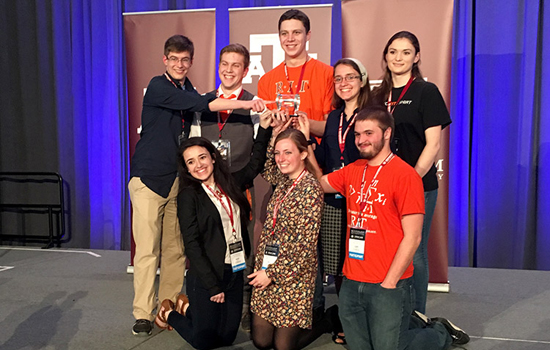Students win award in SpaceX Hyperloop competition
Interdisciplinary team recognized for novel approach
A team of RIT undergraduates won the Special Innovation Award in the Other Subsystem category at the SpaceX Hyperloop Pod Design Competition at Texas A&M University on Jan. 29-31. They are, from left to right in the front row, Kristina Carucci, second-year imaging science; Emily Faw, second-year motion picture science; Zachary Assenmacher, second-year physics; in the back row, Nate Dileas, second-year imaging science; Ryan Hartzell, second-year imaging science; Jeff Maggio, second-year imaging science; Solomiya Vysochanska, second-year mechanical engineering; and Tyler Kuhns, second-year imaging science. Faculty advisers are Harvey Rhody and Joe Pow in RIT’s Chester F. Carlson Center for Imaging Science.
An interdisciplinary team of undergraduates from Rochester Institute of Technology won a Special Innovation Award at the SpaceX Hyperloop Pod Design Competition held at Texas A&M University, Jan. 29-30.
The students received the award in the subsystem category for their novel approach to tube diagnostics and optical communication for the proposed futuristic high-speed rail system. They were one of nine teams awarded in the subsystem category. RIT President Bill Destler and the Chester F. Carlson Center for Imaging Science sponsored the team.
SpaceX and Tesla employees judged the projects.
Elon Musk first proposed the Hyperloop idea in 2013, and his company, SpaceX, is one of several seeking to accelerate the development of a system prototype. Musk proposed a national challenge—to build a scaled-down pod model and necessary Hyperloop sub-systems.
Two undergraduate teams from RIT participated in the design weekend. They were among 115 U.S. and international universities vying for the opportunity to contribute to the Hyperloop concept, a multi-passenger pod or capsules speeding through a series of depressurized tubes.
Their designs include a high-speed communications system and a sensor system to detect faults in the walls of the tube that could impede the motion of the pod. Both are relatively new technologies applied to a higher speed environment.
“It is an entirely imaging-based method,” said Kristina Carucci, a second-year motion picture sciences major. “Other traditional methods that are used to scan tubes, like oil pipelines, would not work in this case. Scanning the walls of the tube will use what is called ‘structured light,’ and it is commonly used to make 3D maps of stationary objects for scientific purposes. But it has never been used at such high speeds.”









